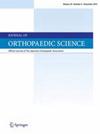涉及下极的髌骨骨折与术后髌骨钡餐有关 - 一项回顾性多中心研究。
IF 1.5
4区 医学
Q3 ORTHOPEDICS
引用次数: 0
摘要
背景:涉及下极骨折(IPF)的髌骨骨折可能与髌骨钡餐(Patella baja)有关,但这种情况的临床影响仍不清楚。本研究旨在阐明:1)髌骨骨折术后髌骨折的发生率;2)存在和不存在髌骨折的相关临床结果;3)CT 检测到 IPF 与发生髌骨折之间的潜在相关性:我们进行了一项回顾性多中心研究,涉及 251 名接受手术治疗的髌骨骨折患者。患者被分为髌骨(PB; n = 49)组和髌骨(PN; n = 202)组。收集的数据包括人口统计学、放射学检查结果、手术细节和术后并发症。我们对 PB 组和 PN 组的这些项目进行了比较。我们使用逻辑回归分析来确定髌骨折叠的风险因素:术后不久,36 例(14.3%)患者出现髌骨折,术后 6 个月时增至 49 例(19.5%)。PB组和PN组在人口统计学、手术细节、临床结果和并发症方面没有明显差异。而在放射学评估中,髌骨正常组在 CT 扫描中的 IPF 患病率明显高于髌骨正常组。通过逻辑回归分析,CT 上的 IPFP 被确定为髌骨后凸的独立风险因素。(结论:结论:在髌骨骨折患者中,髌骨折的发生率从术后即刻的14.3%上升到六个月检查时的19.5%。在髌骨固定组和正常组之间,临床结果无明显差异。CT显示涉及IPF的髌骨骨折是髌骨折的预测因素。本文章由计算机程序翻译,如有差异,请以英文原文为准。
Fracture of the patella involving inferior pole is associated with postoperative patella baja - A retrospective multicenter study
Background
The patella fracture involving of inferior pole fractures (IPF) may be associated with patella baja, However, the clinical impact of this condition remains unclear. This study aims to clarify 1) the incidence of patella baja following patellar fracture surgery, 2) the associated clinical outcomes with and without the presence of patella baja, and 3) the potential correlation between the detection of IPF on CT and the occurrence of patella baja.
Methods
We conducted a retrospective multicenter study involving 251 patients who underwent surgical treatment for patellar fractures. Patients were divided into the patella baja (PB; n = 49) group and patella norma (PN; n = 202) group. Data collected included demographics, radiographic findings, surgical details, and postoperative complications. We compared these items between PB group and PN group. Logistic regression analyses were used to identify risk factors for patella baja.
Results
Immediately following surgery, 36 (14.3%) patients presented with patella baja which increased to 49 cases (19.5%) at six months postoperatively. There is no statistically significant difference in the demographics, surgical details, clinical outcomes and complication between PB group and PN group. While, in the radiographical assessment, the prevalence of IPF on CT scan in the patella baja group was significantly higher than that in the patella norma group. By logistic regression analysis, IPFP on CT was identified as an independent risk factor for patella baja. (odds ratio 2.11, 95% confidence interval: 1.03–4.33, p = 0.042).
Conclusion
In patients with patellar fractures, the incidence of patella baja increased from 14.3% immediately post-surgery to 19.5% at the six-month check-up. No significant differences were observed in clinical outcomes between the patella baja group and the norma group. The patella fracture involving IPF on CT emerged as a predictive factor for patella baja.
求助全文
通过发布文献求助,成功后即可免费获取论文全文。
去求助
来源期刊

Journal of Orthopaedic Science
医学-整形外科
CiteScore
3.00
自引率
0.00%
发文量
290
审稿时长
90 days
期刊介绍:
The Journal of Orthopaedic Science is the official peer-reviewed journal of the Japanese Orthopaedic Association. The journal publishes the latest researches and topical debates in all fields of clinical and experimental orthopaedics, including musculoskeletal medicine, sports medicine, locomotive syndrome, trauma, paediatrics, oncology and biomaterials, as well as basic researches.
 求助内容:
求助内容: 应助结果提醒方式:
应助结果提醒方式:


